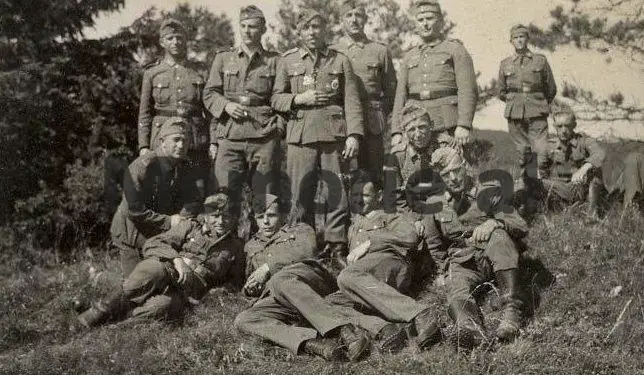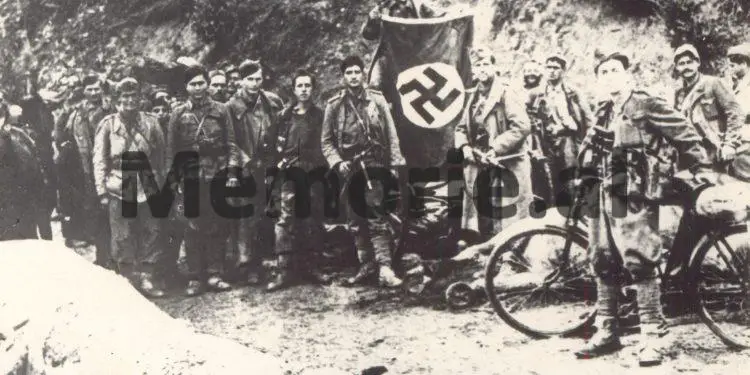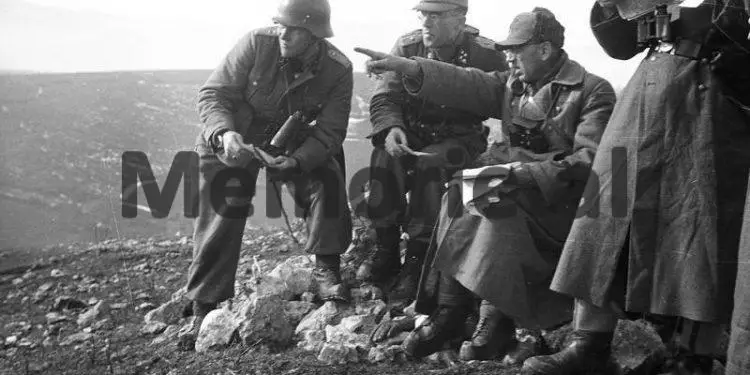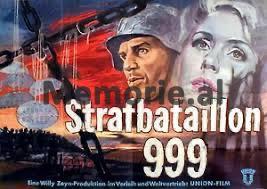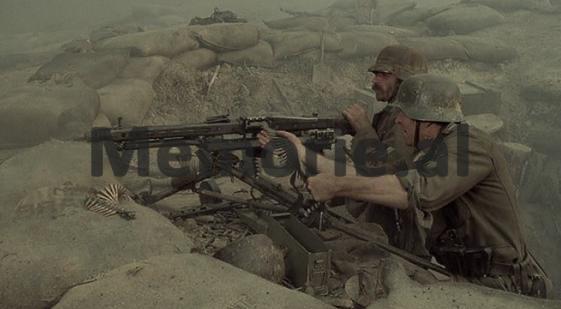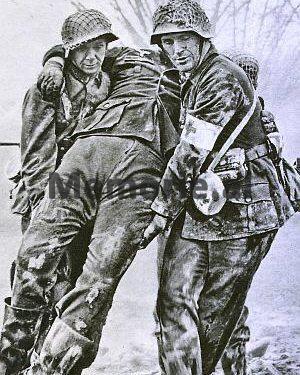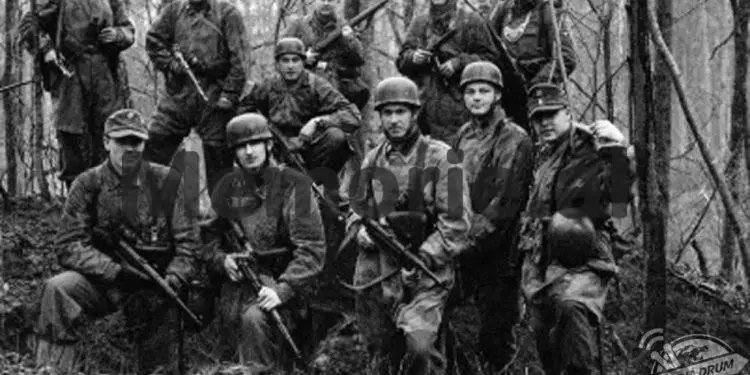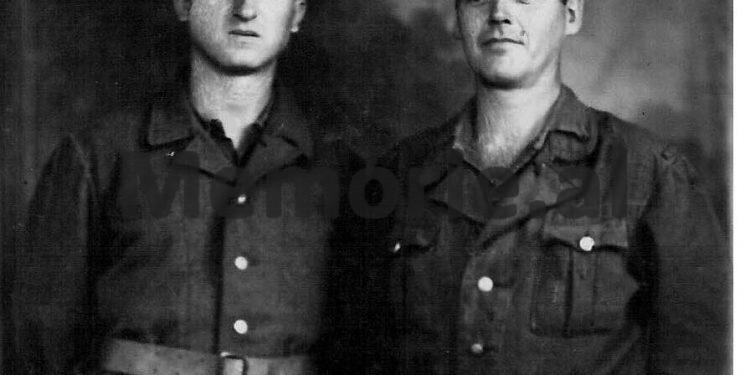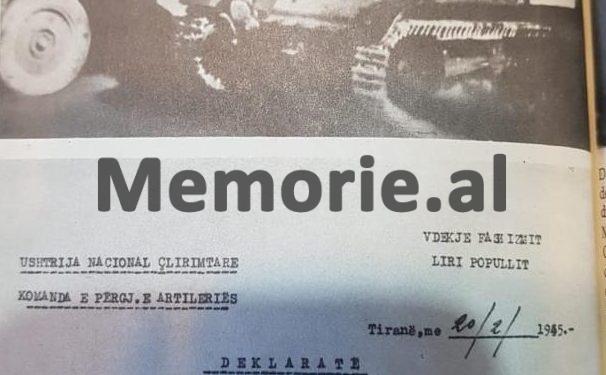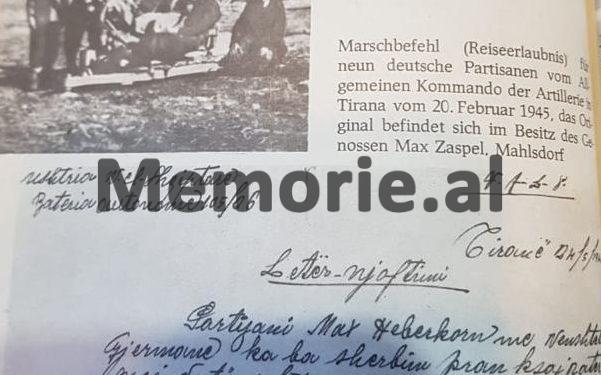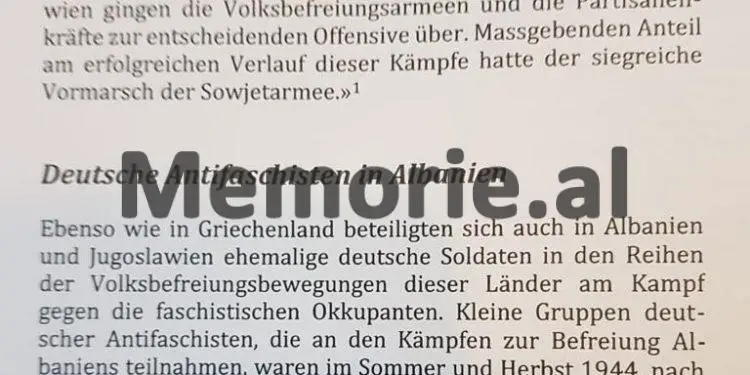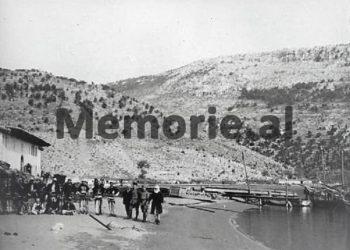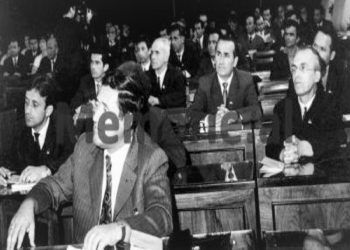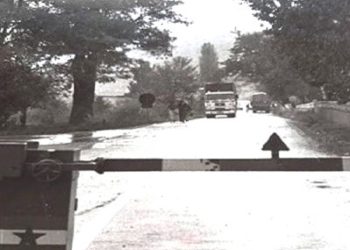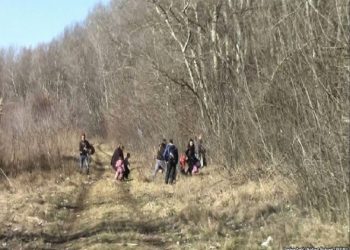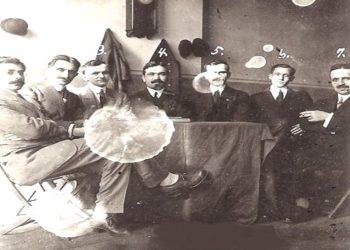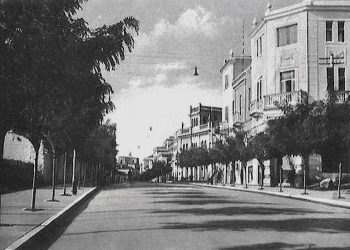Dashnor Kaloçi
Memorie.al publishes the unknown story of Hitler’s Nazi military unit called “999 Division”, otherwise known as “People with the blue mark”, or “Germany Sludge”, as that unit consisted of a conglomeration of people from the most social strata various, such as: ordinary thieves, communists, anti-fascists, pacifists, anarchists, trade unionists, social democrats, etc., who after being held for years in a concentration camp in Heiberg, Germany, with the start of the War, on September 3 1939, a few days before the attack on Poland, at the suggestion of the German Police Chief of Intelligence, Heydrich, Hitler mobilized them in the Nazi armies, sending them to the war fronts in several European countries, such as France, Italy, Poland , Soviet Union, Romania, Bulgaria, Greece, Albania, and as far as North Africa.
Their desertion from the war fronts to all the countries where they went, joining the local partisans and fighting against their former Nazi Hitler compatriots, as they did in Albania since the beginning of the autumn of 1944, coming from Greece , where they had fought alongside the ELAS partisan forces since July 1943. Among the main officers who crossed with the Albanian partisans was the commander of the artillery battery, Sepp Moritz from Graz, Austria, Herman Heurich, the commander of the 8th battery of, Walter Brehdow and Paul Ludvik, (commander and deputy commander of the 9th Battery) Otto Koch and Cuke Will. Ernest Oschmann, Willi Perletberg, Hans Ressmann, Mikael Schifer, etc. followed their example.
How did they get in touch with the main leaders of the partisan formations, operating in the south of Albania, such as: Lieutenant Colonels Hulusi Spahiu and Irfan Peshtani, Captain Abdurrahman Guri, Lieutenant Aleks Duro, etc., becoming effective of those partisan units operating in the area of Konispol, Saranda, Delvina, etc., where they fought against their former compatriots, the Hitler Nazis, giving a great contribution to the liberation of Delvina, Saranda, Elbasan, Tirana, Shkodra, etc., up to the provinces of Northern Albania where they were part of the First Division of the National Liberation Army commanded by Enver Hoxha and Spiro Moisiu!
In the summer of 1944, they deserted from the ranks of Adolf Hitler’s German army forces and sided with the Albanian partisans, becoming members of Enver Hoxha’s National Liberation Army brigades, which were concentrated in the Delvina, Saranda and Gjirokastra, etc. Most of that contingent enlisted in the “999th Division”, or as they were otherwise known in Germany nicknamed the “People with the Blue Mark”, took an active part in several battles, fighting with arms in hand against their Nazi compatriots.
Even giving a very valuable contribution in the ranks of partisan brigades, such as the battles for the liberation of Delvina, Saranda, Elbasan, Tirana or northern Albania. But what was the past of those members of Hitler’s Nazi army who in the second half of 1944 agreed to fight alongside Albanian partisans against their former comrades and where did they come to Albania? What was their contribution to the partisans and why did the historiography of the communist regime never recognize their role as it did with the Italian soldiers who enlisted in the ranks of Enver Hoxha’s National Liberation Army?
How was the 999 Division created?
Since coming to power in 1932, Hitler established a concentration camp in Heiberg, Germany, which was a remote place, like a real desert, where there was not even a village around. That camp included contingents of various social strata, such as: ordinary thieves, pacifists, anarchists, anti-fascists, humanists, trade unionists, social democrats, communists, etc., who was subjected to unprecedented physical and psychological violence.
About 9,000 people were initially admitted to the barracks of that camp and its creation was considered an ideal decision for the realization of Nazi goals, as potential opponents of the ruling regime, after that “would suffer a slow physical destruction”! By the end of 1941, the number of prisoners in that camp as opponents of the Nazi regime had risen to about 300,000, prompting Hitler to send some of them to prisons. On September 3, 1939, two days before Nazi Germany invaded Poland, Hitler and Himmler summoned the head of the State Police Secret Service, Heydrich, who was told to find a solution to that large contingent of people in that camp. Heydrich, with the approval of the Wehrmacht, divided them into two groups, where he locked the most dangerous in concentration camps, and mobilized the rest in a Division codenamed 999, or as it was otherwise known: “People with the blue mark”.
Keeping them under strict supervision, Hitler then sent that unit to the front, as in North Africa, France, Italy, Poland, the Soviet Union, Romania, Bulgaria, Greece and Albania. Although Hitler’s secret police operated in the ranks of the “999th Division”, which had the task of physically destroying any person who disobeyed the orders of superiors, most of that contingent deserted from the ranks of the Nazi army and joined with local partisans wherever they went. For the first time the troops of the “999th Division” were placed under the orders of the famous general Romel, who operated in Africa, and after his defeat, those units came to Italy, France, Belgium and the Balkans, initially operating in Greece. After the entry of Nazi troops in the Balkans, (Greece and Albania) “999 Division” gained its first contacts with the Greek People’s Liberation Army of ELAS. This happened on July 14, 1943, about five weeks after they had entered Greece. In the fight for the liberation of Greek territories, alongside ELAS, 170 members of the “999 Division” were killed. It is worth mentioning the heroism they showed in the fierce fighting that took place in Amalas. After that, in July 1944, the “German Anti-Fascist League” was formed in the Peloponnese, which joined the Greek Army’s Third Division of ELAS.
The Germans who liberated Delvina from the Nazis
For the first time the forces of the “999th Division” entered Albania in small groups in the summer and autumn of 1944, after the occupation of Greece by British troops. After entering the Albanian territory, the German anti-fascists settled in the area of Delvina and Gjirokastra, cooperating closely with the partisan forces operating in that area. Most of them (about 500 people) fought with weapons in hand against their Nazi compatriots, taking part not only in the liberation of Delvina and Saranda, but also in northern Albania, where partisan brigades were later stationed where they were framed.
In the ranks of the Albanian partisans fought not only those Germans who had previously collaborated with ELAS in Greece, but also the Nazi army located in Delvina and Saranda, as all of them were from the “999 Division”. In this area they found the case and immediately sided with the Albanian partisans. It is worth noting the hospitality offered to them by the local population, who treated those troops very well, even though they knew they were opposing forces fighting against their partisan sons. The Germans themselves were surprised by the hospitality of the local population in the South of Albania, as the official propaganda of Berlin, had presented them, as if they were waiting with rifles and immediately shot every German they found. After that, the fear was broken and the desertion of the “999th Division” was done en masse.
And despite the efforts and care of the German General Command in Berlin, the 8th Battery of the third unit of the Artillery Regiment of the “999 Division” also deserted. Thus many effectives of this Division, who drove vehicles with food and ammunition, deviated from their destination and sent them to the partisan forces operating from Ioannina to Delvina. Among the main officers who passed with the partisans were the commander of the artillery battery, Sepp Moritz from Graz, Austria, Herman Heurich, commander of the 8th battery, Walter Brehdoe and Paul Ludvik, (commander and deputy commander of the 9th Battery ) Otto Koch and Cuke Will. Their example was followed by Ernest Oschmann, Willi Perletberg, Hans Ressmann, Mikael Schifer, etc., who left the Nazi units where they had joined and joined the Albanian partisans, fighting alongside them in the liberation of Saranda and Delvina.
Germany Musil: How we saved Delvina
Regarding these events that took place in 1944 in the South of Albania, the German Artur Musil, effective of the “999th Division”, wrote in his book, among other things: “According to the plan of our command (German Nazi), until the evening of October 10, Delvina had to be attacked and completely destroyed. I, as the commander of the third unit, together with a friend of mine, Major Haring, ordered our soldiers to cross immediately before the start of the attack on the Albanian partisans. While the major and I found a pair of Albanian peasant clothes, which they generously gave us. After that we rode on donkeys and passing over a mountain pass, we went to the area controlled by the partisans. My friend the major, shot to walk more on foot and the German units that spotted our action, started firing at us with mortars injuring one of the animals we had ridden. This slowed down our movement and we barely made it to evening where we had started. As we walked, the sky meanwhile began to fill with black clouds and rumble. My friend held me by the hand and calmed me: Better in the rain than in the bullets of the Germans. Walking, we thought of going back to some peasant house. Meanwhile when I looked out of Delvina, I saw that my unit was completely gone. It reminded me of how I had hurriedly forgotten a bag with some of my personal belongings in the barracks. The next day we were able to get in touch with the partisan headquarters operating in the area where we were leaving. We gave them the details of the plan that was supposed to attack Delvina (the plan of the Nazi headquarters) and then within a very short time, the Albanian units together with us, made reorganization and attacked first. This caused the German units to be completely destroyed and the attack on Delvina to be avoided. Then followed days of friendship and war with Albanian partisans in other areas against the same enemy and for the same purpose.
Alfred Kluëe: Korçar saved my life from the SS officer
Another effective German of the “999th Division” who was in Albania and who later deserted and joined the partisans in the war against his Nazi compatriots was also the commander of Alfred Kluëe Battalion. Regarding the events of that time, in his memoirs published in Artur Musil’s book, he wrote, among other things: “When our unit was walking towards Korça, we found the case and deserted. While I was with my friend from Berlin, Paul Baleski, we greeted a villager who responded cordially. Through our translator we explained to the villager our intention that he should not be afraid. We asked him to tell us where the partisan squads were. After fully trusting us, he also told us that there was a food and ammunition depot nearby that the Albanian people and liberators needed so much. I ordered all our soldiers to stay and go to the depot with the villagers. When we reached in front of her, I noticed that she was guarded by two SS soldiers. After greeting them, I told one of them that my unit needed food. He trusted me and I and the villager went inside to see and get something. But suddenly one of the SS officers (the second already alone) suspected and pulled out his revolver to shoot me. At that moment the villager who was with me, immediately pulled out a knife he had with him, and physically eliminated the officer, miraculously saving my life for me. When we got out of the depot, the second SS officer, we immediately arrested him without any problems, and then returned to our unit. After that we went back to the warehouse together with the unit and got considerable quantities of food, clothes and ammunition, thus helping the population of that area and the partisans. “Since that day, we, together with the partisan units of that area, have participated in many fights in the area of Shpati i Elbasanit, as well as in the Elbasan-Tirana”
Likewise, other members of the “999 Division” have served the Albanian partisans as specialists in various fields, such as radio communications, drivers, or journalists. Thus, it is worth mentioning the case of Oskar Fuselbach (member of the German PSD) who helped in the Prefecture of Vlora, near the newspaper of that prefecture. He lived with an Albanian family at the time and provided great help to his Albanian colleagues, who were young and inexperienced in the field of journalism. The number of effective German soldiers of the “999th Division” who deserted from the Führer’s army and joined the Albanian liberators, was over 500 people. Their contribution to this war has been very significant and they have fought until the liberation of Albania in its last city, Shkodra, coming there with fighting from the Durrës-Tirana-Shkodër road.
Partisan documents: The Germans fought alongside us
Although during the 45 years of the communist regime of Enver Hoxha in the book History of the Anti-Fascist National Liberation War (1939-1944) it was never written about the contribution of these German soldiers, completely ignoring that fact, many of those former German soldiers and officers have preserved and have at their disposal many documents that best prove their participation in the war alongside the Albanian partisans. They have preserved to this day many of the testimonies, statements and certificates that the former commanders and commissars of various units of the partisan army had issued to them at the time.
Thus some of those testimonies say:
“National Liberation Army
General Artillery Command
Death of Fascism Freedom of the People Tirana on 13.2.1945
Declaration
It is confirmed that the so-called Max Zaspel, has been in the ranks of the Albanian National Liberation Army and from 25.1.1945 effective of this command as an artilleryman.
Artillery Commander
Lieutenant Colonel Hulusi Spahiu (firm)
Also in another document issued by Hulusi Spahiu, (after the war Major General and Director of Artillery at the Ministry of Defense) it is written:
Travel letter
The following partisans with German citizenship are authorized to travel to Elbasan, who continue their journey to the Eastern Front, without any obstruction from this command.
- Partizan Max Zaspel.
- Paul Ludwig.
- Albin Tomaschek.
- Hans Bauer
- Max Wolf
- Walter Bredoë
- Robert Kraus
- Joseff Gennoch
- Alex Kauffman
In addition to these documents signed by the former partisan commander of the Artillery, Lieutenant Colonel Spahiu (imprisoned by Enver Hoxha in the 1950s), in the book of the German author, Artur Musil, many other signed documents are given in facsimiles by other partisan commanders and commissars well known both at that time and later, such as: Irfan Peshtani, Abdurrahman Guri, Aleks Spiro, etc. But although these documents shed light and speak clearly on the participation of 500 Germans in the ranks of Enver Hoxha’s partisan National Liberation Army, this was never written in the history books or memoirs of war veterans before the 1990s and in these three decades after the collapse of the communist regime… ?!
In 1960, director Harold Phillipe made a film about the 999th Division, which caused a stir in West Germany.
During and at the end of World War II, many of the former members of the 999th Division, or as they were otherwise known in Nazi Germany, as the “People with the Blue Mark”, did not return to their homeland, but preferred to to stay in exile, where they created the first nucleus of the German Communist Party, which a few years later would come to power in East Germany. Many others from the 999th Division, immediately after the War, occupied important positions and functions in the East German communist government and the hierarchy of party leadership that led it. Even some of the former Nazi soldiers of the “999 Division” who had once fought in Albania alongside Enver Hoxha’s partisans, in the ’50s and’ 60s returned here as tourists, students, or with various government delegations. The story of the Nazi division consisting of “People with the blue mark”, or as they were otherwise known with contempt by the Hitlerite Nazis, as “Sludge of Germany”, in 1960 shattered the fantasy of the famous German director Harald Phillipe, who made the feature film feature film, entitled “Straftbattalion 999”. This film, in which the two main roles were played by actors Werner Peters and Sonja Ziemman, caused a great commotion in West Germany at that time, because it dealt with a topic and story unknown until then, that of Nazi dissent./Memorie.al




